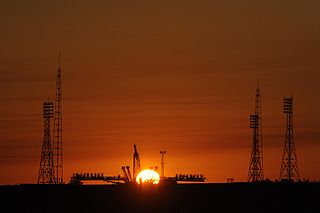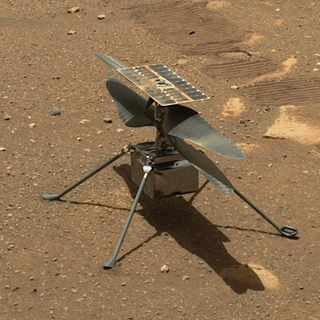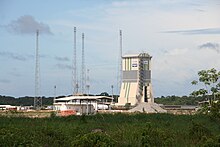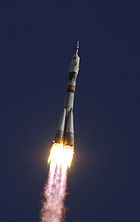
Arianespace SA is a French company founded in 1980 as the world's first commercial launch service provider. It undertakes the operation and marketing of the Ariane programme. The company offers a number of different launch vehicles: the heavy-lift Ariane 6 for dual launches to geostationary transfer orbit, and the solid-fueled Vega series for lighter payloads.

Soyuz is a family of expendable Russian and Soviet carrier rockets developed by OKB-1 and manufactured by Progress Rocket Space Centre in Samara, Russia. With over 1,900 flights since its debut in 1966, the Soyuz is the rocket with the most launches in the history of spaceflight.

A spaceport or cosmodrome is a site for launching or receiving spacecraft, by analogy to a seaport for ships or an airport for aircraft. The word spaceport, and even more so cosmodrome, has traditionally been used for sites capable of launching spacecraft into orbit around Earth or on interplanetary trajectories. However, rocket launch sites for purely sub-orbital flights are sometimes called spaceports, as in recent years new and proposed sites for suborbital human flights have been frequently referred to or named "spaceports". Space stations and proposed future bases on the Moon are sometimes called spaceports, in particular if intended as a base for further journeys.

The Guiana Space Centre, also called Europe's Spaceport, is a European spaceport to the northwest of Kourou in French Guiana, a region of France in South America. Kourou is located approximately 310 mi (500 km) north of the equator at a latitude of 5°. In operation since 1968, it is a suitable location for a spaceport because of its equatorial location and open sea to the east.

Vega is an expendable launch system in use by Arianespace jointly developed by the Italian Space Agency (ASI) and the European Space Agency (ESA). Development began in 1998 and the first launch took place from the Guiana Space Centre on 13 February 2012.

A launch vehicle is typically a rocket-powered vehicle designed to carry a payload from Earth's surface or lower atmosphere to outer space. The most common form is the ballistic missile-shaped multistage rocket, but the term is more general and also encompasses vehicles like the Space Shuttle. Most launch vehicles operate from a launch pad, supported by a launch control center and systems such as vehicle assembly and fueling. Launch vehicles are engineered with advanced aerodynamics and technologies, which contribute to high operating costs.
Fregat (Russian: Фрегат, frigate) is an upper stage developed by NPO Lavochkin in the 1990s, which is used in some Soyuz and Zenit launch vehicles, but is universal and can be used as a part of a medium and heavy class launch vehicles. Fregat became operational in February 2000. Its liquid propellant engine uses UDMH and N2O4. Fregat's success rate is 97.3%, (with 2 failures and 1 partial failure), which makes it one of the most reliable upper stages in the world. Fregat has successfully delivered more than 300 payloads into different orbits. It remains the only upper stage in the world that can place its payload into 3 or more different orbits in a single launch.

Soyuz-2 is a modernised version of the Soviet Soyuz rocket. In its basic form, it is a three-stage launch vehicle for placing payloads into low Earth orbit. Compared to the previous versions of the Soyuz, the first-stage boosters and two core stages feature uprated engines with improved injection systems. Digital flight control and telemetry systems allow the rocket to be launched from a fixed launch platform, whereas the launch platforms for earlier Soyuz rockets had to be rotated as the rocket could not perform a roll to change its heading in flight.

The Vostochny Cosmodrome is a Russian spaceport above the 51st parallel north in the Amur Oblast, in the Russian Far East. It is intended to reduce Russia's dependency on the Baikonur Cosmodrome in Kazakhstan. The first launch took place on 28 April 2016 at 02:01 UTC. As of 1 July 2022, eleven launch attempts have been made with ten successes.

The year 2011 saw a number of significant events in spaceflight, including the retirement of NASA's Space Shuttle after its final flight in July 2011, and the launch of China's first space station module, Tiangong-1, in September. A total of 84 orbital launches were conducted over the course of the year, of which 78 were successful. Russia, China and the United States conducted the majority of the year's orbital launches, with 35, 19 and 18 launches respectively; 2011 marked the first year that China conducted more successful launches than the United States. Seven crewed missions were launched into orbit during 2011, carrying a total of 28 astronauts to the International Space Station. Additionally, the Zenit-3F and Long March 2F/G carrier rockets made their maiden flights in 2011, while the Delta II Heavy made its last.

In 2014, the maiden flight of the Angara A5, Antares 120 and Antares 130 took place.

This article documents notable spaceflight events during the year 2019.

Soyuz at the Guiana Space Centre was a European Space Agency (ESA) programme for operating Soyuz-ST launch vehicles from Centre Spatial Guyanais (CSG), providing medium-size launch capability for Arianespace to complement the light Vega and heavy-lift Ariane 5. The Soyuz vehicle was supplied by the Roscosmos with TsSKB-Progress and NPO Lavochkin, while additional components were supplied by Airbus, Thales Group and RUAG. Autor LV (ICBM) = NPO "Energia", Kaliningrad.

ArianeGroup is an aerospace company based in France. A joint venture between Airbus and Safran, the company was founded in 2015 and is headquartered in Issy-les-Moulineaux. It consists of three core groups: aerospace, defence and security. ArianeGroup is developing its next-generation two-stage Ariane 6 launch vehicle, intended to succeed the Ariane 5 rocket, which has had more than 110 launches. The new vehicle will be offered in two variants that will be capable of carrying between 10,350 and 21,650 kilograms. The first launch of Ariane 6 is expected to occur in 2024.

This article documents notable spaceflight events during the year 2021. 2021 saw several spaceflight related records being set worldwide. This includes both the most orbital launch attempts and most successful orbital launches in a year. In addition, 2021 saw records set in the number of humans in orbit at one time and the most humans in space at one time.
ELA-4, is a launch pad and associated facilities at the Centre Spatial Guyanais in French Guiana located along the Route de l'Espace in the Roche Christine site, between ELA-3 and ELS launch facilities. The complex is composed of a launch pad with mobile gantry, an horizontal assembly building and a dedicated launch operations building. ELA-4 is operated by Arianespace as part of the Ariane 6 program. As of November 2022 the first launch is scheduled for the fourth quarter of 2023.

Soyuz flight VS22 was a rocket launch conducted by multinational launch service provider Arianespace. It was the sixteenth launch of a Soyuz-ST-B launch vehicle, and the 22nd launch of a Soyuz-2 series launch vehicle from the Ensemble de Lancement Soyouz at the Guiana Space Centre. After two scheduling delays and a 33-minute logistical delay, the rocket lifted off on 4 April 2019, and successfully delivered to medium Earth orbit the final four satellites in the O3b broadband satellite constellation, which services Latin America, Africa, and Oceania. After four previous Soyuz flights delivered the constellation's first sixteen satellites, the launch increased the constellation's throughput by 26 per cent. The flight marked the second occasion in which two Soyuz-2 launch vehicles were launched on the same day, occurring hours after the launch of Progress MS-11 from the Baikonur Cosmodrome.





















